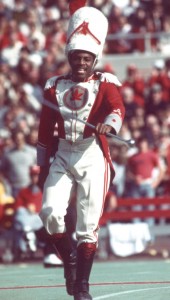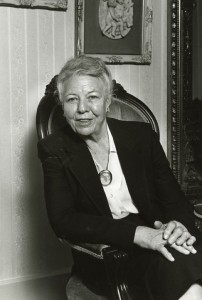(Editor’s note: Below, Karen Lane, an OSU alumna, writes a wonderful short history of her aunt and uncle’s love of the Buckeyes that marked their long, long happy marriage. Have a similar story of OSU football faithfuls? Contact Kevlin Haire at haire.14@osu.edu. We want to most sincerely thank Karen for sharing both her relatives’ story and some wonderful photos of them.)
On September 26, 1934, Glenn and Virginia Spangler stepped onto The Oval as freshmen, who became incidentally, the youngest married couple to simultaneously attend The Ohio State University. Glenn was 19 and his bride of four months was just 17. Their marriage was for a lifetime as was their love for OSU.
Enrolled as students in the College of Education, Glenn and Virginia spent a four-year honeymoon at Ohio State, studying, sometimes chaperoning student events, and on many weekends going “home” to help work the Armstrong farm on Salt Creek (Pickaway/Hocking Counties) near Laurelville, Ohio. But on football weekends there were no trips to southern Ohio, only west to Ohio Stadium.
On October 6, 1934, Glenn and Virginia watched the Buckeyes trounce Indiana, 33 to 0, under the direction of new head football coach, Francis Schmidt. From that victory until they graduated in 1938, the young Spanglers were on hand to cheer the OSU football team to victory.
After graduation, Glenn and Virginia became beloved teachers, first at North Canton High School and then in the Bellevue (Ohio) schools. They regularly made trips south to help on the farm and, during football season, to watch the OSU Buckeyes play.
In 1961 they settled permanently in Central Ohio, building a house in the booming little suburb of Grove City. It was from this house that a weekly tradition began: If the Bucks played at home, a hamper full of fried chicken, coleslaw and cake shared trunk-space with blankets and a thermos of hot chocolate for a tailgate picnic beside Ohio Stadium. Televised away-games were anticipated, talked about, watched and dissected by all who dropped in for a visit during football season. If the game was not televised, then the radio was tuned in to the game.
In the early 1980s, Glenn bought an RCA video camera and recorder, which regularly taped OSU games that were inconveniently aired on Channel 34 Sunday mornings during church. And when QUBE, the precursor to cable television, was pioneered in Columbus, they became one of the first subscribers . . . to watch OSU football.
After retiring from South-Western City Schools, Glenn and Virginia also traveled to watch the team. Trips with their football-loving nephews took them to nearby Big Ten games – Indiana, Illinois and Northwestern. They attended at least two Rose Bowls, a Gator Bowl, and to one last trip out west for the Fiesta Bowl.
After Glenn’s death in 1990, Virginia continued to follow the Buckeyes on television and in the newspaper. Although no longer able to attend all the games in the Stadium she continued to purchase season tickets, which she shared with her family, passing on her (and Glenn’s) affection for the game and for the Ohio State University Buckeyes.
A brief genealogy of Glenn and Virginia Spangler:
Glenn Edison Spangler (03 March 1915 – 22 May 1990)
Virginia Adele Armstrong Spangler (11 August 1917 – 08 March 2005).
Adelphi (Ohio) High School graduates: Glenn-1932. Virginia – 30 April 1934.
Married in Greenup, Kentucky – 03 May 1934
Ohio State University graduates – 13 June 1938











Recent Comments